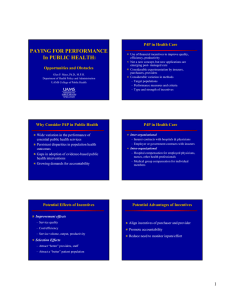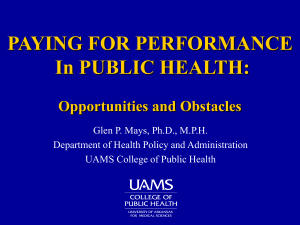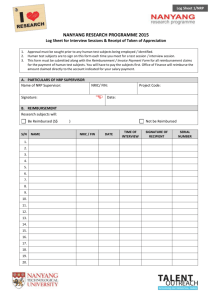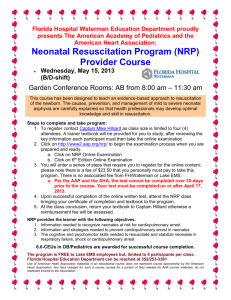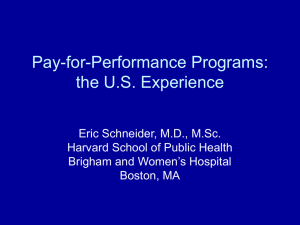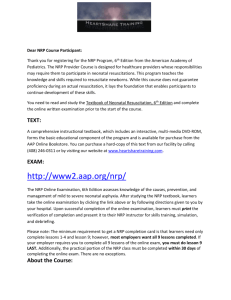Previous Research
advertisement
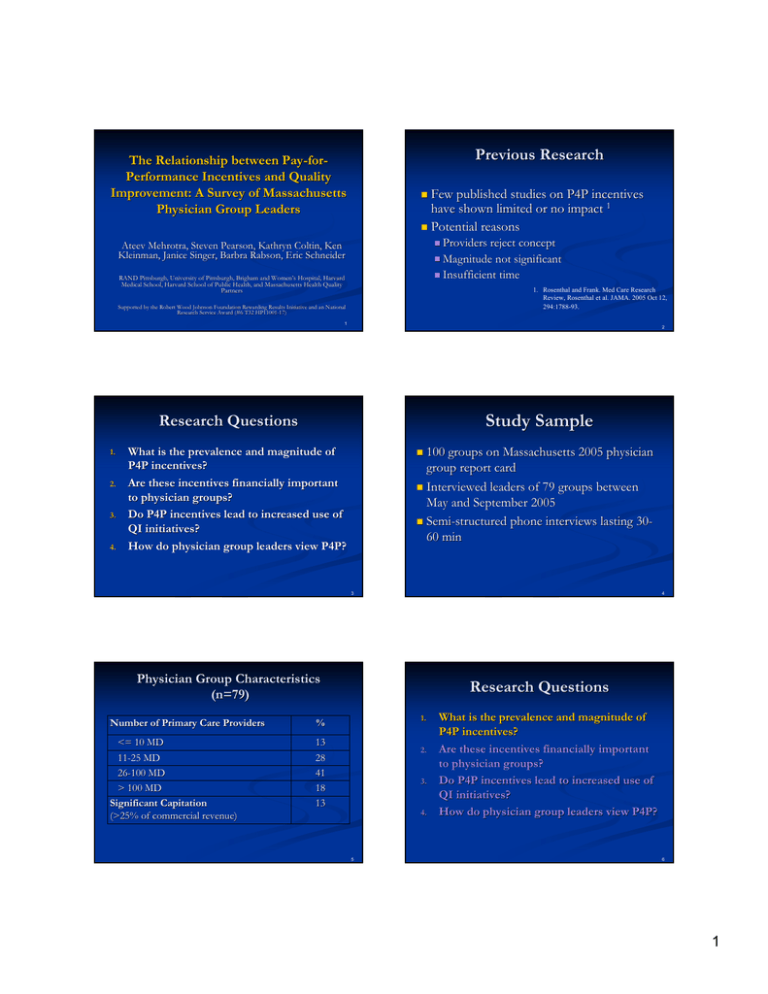
Previous Research The Relationship between PayPay-forforPerformance Incentives and Quality Improvement: A Survey of Massachusetts Physician Group Leaders Few published studies on P4P incentives have shown limited or no impact 1 Potential reasons Providers reject concept not significant Insufficient time Ateev Mehrotra, Steven Pearson, Kathryn Coltin, Coltin, Ken Kleinman, Kleinman, Janice Singer, Barbra Rabson, Rabson, Eric Schneider Magnitude RAND Pittsburgh, University of Pittsburgh, Brigham and Women’ Women’s Hospital, Harvard Medical School, Harvard School of Public Health, and Massachusetts Massachusetts Health Quality Partners 1. Rosenthal and Frank. Med Care Research Review, Rosenthal et al. JAMA. 2005 Oct 12, 294:1788-93. Supported by the Robert Wood Johnson Foundation Rewarding Results Results Initiative and an National Research Service Award (#6 T32 HP11001HP11001-17) 1 2 Study Sample Research Questions 1. 2. 3. 4. What is the prevalence and magnitude of P4P incentives? Are these incentives financially important to physician groups? Do P4P incentives lead to increased use of QI initiatives? How do physician group leaders view P4P? 100 groups on Massachusetts 2005 physician group report card Interviewed leaders of 79 groups between May and September 2005 SemiSemi-structured phone interviews lasting 303060 min 3 4 Physician Group Characteristics (n=79) Number of Primary Care Providers % <= 10 MD 1111-25 MD 2626-100 MD > 100 MD Significant Capitation (>25% of commercial revenue) 13 28 41 18 13 Research Questions 1. 2. 3. 4. 5 What is the prevalence and magnitude of P4P incentives? Are these incentives financially important to physician groups? Do P4P incentives lead to increased use of QI initiatives? How do physician group leaders view P4P? 6 1 Prevalence and Magnitude of P4P in Massachusetts Groups with P4P incentives in health plan contracts Overall revenue tied to P4P Focus of Current P4P Incentives Among Groups with Any P4P (n=71) Groups reporting any P4P tied to measure Measures 89% % 100 HEDIS measures 2.2% (0.3 – 8.0)* Utilization measures 64 Use of EMR or other IT 51 Patient Satisfaction Survey Measures 35 * Limited to 37 groups 7 Evaluation of Financial Importance Stratified by Revenue at Risk Research Questions 1. 2. 3. 4. 8 What is the prevalence and magnitude of P4P incentives? Are these incentives financially important to physician groups? Do P4P incentives lead to increased use of QI initiatives? How do physician group leaders view P4P? <1% 19 P4P are “very important” or “moderately important” to group’s financial success % 11 1-3% 9 22 >3% 9 56 % of Overall Revenue tied to P4P N* * Limited to 37 non-IPA groups with P4P Mantel-Haenzel chi-squared test for trend significant with p value of 0.01 9 Research Questions 1. 2. 3. 4. 10 Use of QI Initiatives What is the prevalence and magnitude of P4P incentives? Are these incentives financially important to physician groups? Do P4P incentives lead to increased use of QI initiatives? How do physician group leaders view P4P? HbA1c Measurement Mammogram Screening Asthma Controller Medication Use Adequacy of Well Child Visits Chlamydia Screening Hyperlipidemia Screening LDL control Hypertension Control 0 11 20 40 60 80 100 12 2 Relationship between P4P & QI Initiatives Variables Associated with Increased Use of QI Initiatives Odds Ratio P (95% CI) Value HbA1c Measurement Mammogram Screening Pay-for-performance incentive Asthma Controller Medication Use Adequacy of Well Child Visits Employed Physician Group Chlamydia Screening Hyperlipidemia Screening Larger group (>39 physicians) P4P Incentive LDL control QI Initiative 1.6 (1.0-2.4) 3.2 (1.5 – 7.1) 2.2 (1.0 - 4.9) 0.04 0.004 0.06 Hypertension Control 0 20 40 60 80 100 13 14 Research Questions 1. 2. 3. 4. Views of P4P What is the prevalence and magnitude of P4P incentives? Are these incentives financially important to physician groups? Do P4P incentives lead to increase use of QI initiatives? How do physician group leaders view P4P? % of Physician Group Leaders Physician groups should be paid based performance on HEDIS measures P4P will lead to quality improvements over next 3 years 77 79 15 16 Limitations Key Findings Findings do not address any problems with how current P4P incentives are structured Does not address actual performance on quality measures Cannot comment on potential adverse impacts of P4P incentives 17 Vast majority of groups face P4P Leaders support concept of P4P tied to HEDIS measures Current magnitude of P4P may be insufficient P4P incentives are associated with increased use of QI initiatives 18 3 Policy Implications Support among physician leaders for incentives based on quality Help us understand the necessary financial magnitude of incentives Demonstrate potential for paypay-forfor-performance incentives to increase attention paid to quality improvement For further information: mehrotra@rand.org 19 Assessing Prevalence of QI Initiatives Independent Variables in Model 20 P4P Incentive on that measure Percentage of Employed Physicians (majority vs. less than majority) Use of EMR (majority use EMR vs. less than majority) Size of group (>39 PCP vs. <=39 PCP) Types of MD (Mostly specialty vs. Equal mix or mostly primary care) Significant capitation Part of a Network Focus on 8 HEDIS measures OpenOpen-ended question FollowFollow-up questions to determine whether met criteria for 12 preprespecified categories of QI initiatives Not all reported QI initiatives coded 21 Ideally What % of Overall Revenue Should be Tied to P4P Incentives? Measures Discussed in Interview HEDIS measures Patient satisfaction survey results Utilization measures Use of EMR or other IT 22 Asthma Controller Medication Use Adequacy of Well Child Visits Chlamydia Screening Mammogram Screening HbA1c Screening Hyperlipidemia Screening in patients with CAD LDL control among patients with CAD Hypertension Control 23 % of Physician Group Leaders Ideal Percentage 5% or Greater 91 24 4
